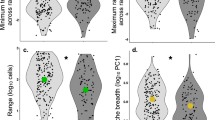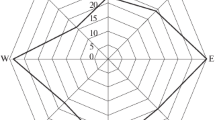Abstract
Arboreal nests of eusocial insects are typically roughly egg- or pear shaped with superficial irregularities, which makes the correct determination of their volume or surface area in the field difficult. Here, we evaluated the accuracy (benefit) of different geometric proxies with varying number of underlying measurements (cost) when assessing the volume and surface area of arboreal termite nests of Microcerotermes indistinctus and Constrictotermes cyphergaster. We compared size measures based on the 3D models with the most common shape models in literature: spheres (1–3 parameters), ellipsoids (3 parameters), cylinders (3 parameters), and a combination of superimposed cylinders with spherical caps (at least 9 parameters). The most complex model returned the most accurate results (low estimation error and low error variability). However, estimation errors did not differ from simpler shape models, based on only three (ellipsoids, spheres using half of the arithmetic mean of height, width and depth as radius) or even a single parameter (spheres using half of depth as radius). Cylindric proxies and spheres based on nest height or width, on the other hand, returned far less accurate results with estimation errors of up to almost 300%. Although nests of M. indistinctus showed a higher variation in shape and more surface irregularities than those of C. cyphergaster, each geometric proxy tested in the present study determined the nest size of both termite species with equal precision. This suggests that each shape model may generate similarly accurate estimates of volume and surface area over a wider range of termite species that build egg-shaped arboreal nests.





Similar content being viewed by others
References
Adams ES, Atkinson L (2008) Queen fecundity and reproductive skew in the termite Nasutitermes corniger. Insect Soc 55:28–36. https://doi.org/10.1007/s00040-007-0970-5
Barca RRB, Lucena EF, Vasconcellos A (2018) Nest population structure and wood litter consumption by Microcerotermes indistinctus (Isoptera) in a seasonally dry tropical forest, northeastern Brazil. Insects 9:97. https://doi.org/10.3390/insects9030097
Bezerra-Gusmão MA, Barbosa JRC, Barbosa MRV, Bandeira AG, Sampaio EVSB (2011) Are nests of Constrictotermes cyphergaster (Isoptera, Termitidae) important in the C cycle in the driest area of semiarid caatinga in northeast Brazil? Appl Soil Ecol 47:1–5. https://doi.org/10.1016/j.jaridenv.2012.11.003
Couto AAVO, Arruda AR, Silva JS, Vega ESF, Moura CCM, Muniz SL, Albuquerque AC (2012) Parameters that influence the establishment and volume of Microcerotermes exiguus and Nasutitermes corniger nests in an Atlantic Forest fragment in Northeastern Brazil (Isoptera: Termitidae). Sociobiology 59:903–910. https://doi.org/10.13102/sociobiology.v59i3.556
Cristaldo PF, Rosa CS, Florencio DF, Marins A, DeSouza O (2012) Termitarium volume as a determinant of invasion by obligatory termitophiles and inquilines in the nests of Constrictotermes cyphergaster (Termitidae, Nasutitermitinae). Insect Soc 59:541–548. https://doi.org/10.1007/s00040-012-0249-3
Cristaldo PF, Cs A, Cruz NG, Ribeiro EJM, Rocha MLC, Santos AA, Santana AS, Araújo APA (2018) The role of resource density on energy allocation in the neotropical termite Nasutitermes aff. coxipoensis (Termitidae: Nasutitermitinae). Neotrop Entomol 47:329–335. https://doi.org/10.1007/s13744-017-0525-z
Danks HV (2002) Modification of adverse conditions by insects. Oikos 99:10–24. https://doi.org/10.1034/j.1600-0706.2002.990102.x
Delaunay B (1934) Sur la sphère vide. A la mémoire de Georges Voronoï. Bull Acad Sci URSS 6:793–800
DeSouza O, Araújo APA, Florencio DF, Rosa CS, Marins A, Costa DA, Rodrigues VB, Cristaldo PF (2016) Allometric scaling of patrolling rate and nest volume in Constrictotermes cyphergaster termites: hints on the settlement of inquilines. PLoS ONE 11:e0147594. https://doi.org/10.1371/journal.pone.0147594
Downes MF (2015) Annual cycle of nest composition in the queen-dimorphic weaver ant Polyrhachis australis Mayr, 1870 (Hymenoptera: Formicidae) in northern Queensland. Austral Entomol 54:87–95. https://doi.org/10.1111/aen.12096
Fernandes CRM, Almeida AB, Del Lama MA, Martins CF (2017) Nesting substrate characteristics of Partamona seridoensis Pedro & Camargo (Hymenoptera: Apidae) in areas of dry forest in Brazil. Sociobiology 64:26–32. https://doi.org/10.13102/sociobiology.v64i1.1143
Gonçalves TT, DeSouza O, Reis R, Ribeiro SP (2005) Effect of tree size and growth on the presence and activity of arboreal termites (Insecta: Isoptera) in the Atlantic Rain Forest. Sociobiology 46:421–432
Goñi SM, Purlis E, Salvadori VO (2007) Three-dimensional reconstruction of irregular foodstuffs. J Food Eng 82:536–547. https://doi.org/10.1016/j.jfoodeng.2007.03.021
Hansell MH (1993) The ecological impact of animal nests and burrows. Funct Ecol 1:5–12. https://doi.org/10.2307/2389861
Henriksen S, Axelsen JA, Lemming KH, Mwatawla M, Offenberg J (2015) The search rate of the African weaver ant in Cashew. Sociobiology 62:519–526. https://doi.org/10.13102/sociobiology.v62i4.740
Hibbler RC (2016) Statics, 14th edn. Pearson Prentice Hall, Hoboken
Hölldobler B, Wilson EO (1990) The ants. Springer, Berlin
Hoyt DF (1979) Practical methods of estimating volume and fresh weight of bird eggs. Auk 96:73–77. https://doi.org/10.1093/auk/96.1.73
Hozumi S, Kudô K, Zucchi R (2008) Promotion of thermoregulatory insulation in nests of neotropical wasps by building extra-combs with empty cells. Neotrop Entomol 37:159–166. https://doi.org/10.1590/S1519-566X2008000200008
Jones RJ (1979) Expansion of the nest of Nasutitermes costalis. Insect Soc 26:322–342. https://doi.org/10.1007/BF02223552
Jones JC, Oldroyd BP (2007) Nest thermoregulation in social insects. Adv Insect Physiol 33:153–191. https://doi.org/10.1016/S0065-2806(06)33003-2
Kratochvíl L, Frynta D (2006) Egg shape and size allometry in geckos (Squamata: Gekkota), lizards with contrasting eggshell structure: why lay spherical eggs? J Zool Syst Evol Res 44:217–222. https://doi.org/10.1111/j.1439-0469.2005.00339.x
Lucena EF, Vasconcellos A, Lopes AO, Moura FMS (2019) Quantitative variations of Constrictotermes cyphergaster (Isoptera) instars over time in a Neotropical semiarid ecosystem. Insect Soc 66:463–470. https://doi.org/10.1007/s00040-019-00707-x
Martins CF, Cortopassi-Laurino M, Koedam D, Imperatriz-Fonseca VL (2004) Tree species used for nidification by stingless bees in the Brazilian Caatinga (Seridó, PB; João Câmara, RN). Biota Neotrop 4:1–8. https://doi.org/10.1590/S1676-06032004000200003
Martius C (1994) Termite nest as structural elements of the Amazon floodplain forest. Andrias 13:137–150
Morato EF, Martins RP (2006) An overview of proximate factors affecting the nesting behavior of solitary wasps and bees (Hymenoptera: Aculeata) in preexisting cavities in wood. Neotrop Entomol 35:285–298. https://doi.org/10.1590/S1519-566X2006000300001
Moura FMS, Vasconcellos A, Araújo VFP, Bandeira AG (2006) Seasonality in foraging behaviour of Constrictotermes cyphergaster (Termitidae, Nasutitermitinae) in the Caatinga of Northeastern Brazil. Insect Soc 53:472–479. https://doi.org/10.1007/s00040-005-0899-0
Noirot C, Darlington JPEC (2000) Termite nests: architecture, regulation and defence. In: Abe T, Bignell DE, Higashi M (eds) Termites: evolution, sociality, symbioses, ecology. Springer Science and Business Media, Dordrecht, pp 121–139
Oliveira TFFN, Silva LL, Hrncir M (2016) Opportunistic occupation of nests of Microcerotermes spp. Silvestri (Termitidae: Termitinae) by Partamona seridoensis Camargo & Pedro (Apidae: Meliponini) in the Brazilian tropical dry forest. Sociobiology 63:731–734. https://doi.org/10.13102/sociobiology.v63i1.975
Pequeno PACL, Franklin E, Venticinque EM, Acioli ANS (2013) The scaling of colony size with nest volume in termites: a role in population dynamics? Ecol Entomol 38:515–521. https://doi.org/10.1111/een.12044
Pinkalski C, Damgaard C, Jensen KMV, Gislum R, Peng R, Offenberg J (2015) Non-destructive biomass estimation of Oecophylla smaragdina colonies: a model species for the ecological impact of ants. Insect Conserv Diver 8:464–473. https://doi.org/10.1111/icad.12126
Prestwich GD (1984) Defense mechanisms of termites. Annu Rev Entomol 29:201–232. https://doi.org/10.1146/annurev.en.29.010184.001221
Roubik DW (2006) Stingless bee nesting biology. Apidologie 37:124–143. https://doi.org/10.1051/apido:2006026
Sena JM, Vasconcellos A, Gusmão MAB, Bandeira AG (2003) Assemblage of termites in a fragment of Cerrado on the coast of Paraíba State, Northeast Brazil (Isoptera). Sociobiology 42:753–760
Taylor MA, Garboczi EJ, Erdogan ST, Fowler DW (2006) Some properties of irregular 3-D particles. Powder Technol 162:1–15. https://doi.org/10.1016/j.powtec.2005.10.013
Tee GJ (2005) Surface area and capacity of ellipsoids in n dimensions. NZ J Math 34:165–198
Thomsen K (2004) Surface area of an ellipsoid. https://www.numericana.com/answer/ellipsoid.htm#thomsen. Accessed 17 Apr 2020
Thorne BL, Haverty MI (2000) Nest growth and survivorship in three species of neotropical Nasutitermes (Isoptera: Termitidae). Environ Entomol 29:256–264. https://doi.org/10.1603/0046-225X(2000)029[0256:NGASIT]2.0.CO;2
Vasconcellos A (2010) Biomass and abundance of termites in three remnant areas of Atlantic Forest in northeastern Brazil. Rev Bras Entomol 54:4555–5461. https://doi.org/10.1590/S0085-56262010000300017
Vasconcellos A, Araújo VFP, Moura FMS, Bandeira AG (2007) Biomass and population structure of Constrictotermes cyphergaster (Silvestri) (Isoptera: Termitidae) in the dry forest of Caatinga, northeastern Brazil. Neotrop Entomol 36:693–698. https://doi.org/10.1590/S1519-566X2007000500009
Vasconcellos A, Bandeira AG, Almeida WO, Moura FMS (2008) Termites that build conspicuous nests in two areas of Atlantic forest under different levels of anthropogenic disturbance. Neotrop Entomol 37:15–19. https://doi.org/10.1590/S1519-566X2008000100003[in Portuguese]
Vasoncellos A, Bandeira AG, Moura FMS, Araújo VFP, Bezerra-Gusmão MA, Constantino R (2010) Termite assemblages in three habitats under different disturbance regimes in the semi-arid Caatinga of NE Brazil. J Arid Environ 74:298–302. https://doi.org/10.1016/j.jaridenv.2009.07.007
Vicente RE, Izzo TJ (2017) Defining habitat use by the parabiotic ants Camponotus femoratus (Fabricius, 1804) and Crematogaster levior Longino, 2003. Sociobiology 64:373–380. https://doi.org/10.13102/sociobiology.v64i4.1228
Watanasit S, Jantarit S (2006) The ant nest of Crematogaster rogenhoferi (Mayr, 1879) (Hymenoptera: Formicidae) at Tarutao National Park, Satun Province, Southern Thailand. Songklanakarin J Sci Technol 28:723–730
Wenzel JW (1991) Evolution of nest architecture. In: Ross KG, Matthews RW (eds) The social biology of wasps. Cornell University Press, Ithaca, pp 480–519
Wiegert RG, Coleman DC (1970) Ecological significance of low oxygen consumption and high fat accumulation by Nasutitermes costalis (Isoptera: Termitidae). Bioscience 20:663–665. https://doi.org/10.2307/1295259
Wilson EO (1971) The insect societies. Oxford University Press, London
Acknowledgements
We would like to thank two anonymous referees for their suggestions and constructive criticism. The present study complies with the current Brazilian laws and was financially supported by a scholarship of the Research Foundation of Rio Grande do Norte (FAPERN: 88882.188362/2015-01) to DFB and by Grants of the of the Brazilian Ministry of Education (CAPES: 3168/2013) and the National Council for Scientific and Technological Development (CNPq: 304722/2010-3, 309914/2013-2, 404156/2013-4) to MH.
Author information
Authors and Affiliations
Corresponding author
Ethics declarations
Conflict of interest
The authors declare that they have no conflict of interest.
Rights and permissions
About this article
Cite this article
Brasil, D.F., Guimarães-Brasil, M.O. & Hrncir, M. Which is the best field method for assessing volume and surface area of arboreal termite nests?. Insect. Soc. 67, 399–410 (2020). https://doi.org/10.1007/s00040-020-00774-5
Received:
Revised:
Accepted:
Published:
Issue Date:
DOI: https://doi.org/10.1007/s00040-020-00774-5




